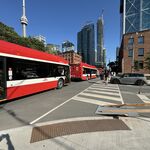dunkalunk
Senior Member
I'd expect at bare minimum 5 years for business case, study, consultation and property acquisition. More likely 8 years *if* funding is committed.
5 years to construction start is pretty typical for large projects like this, look at the scarb. subway.
Damn. If the Liberals win a majority (there's a good chance of that) they'll have at most five years to get construction started on this thing before the next election.
Since day one this has been a special project though....one day we had not heard of it and the next day it was a done deal with Murray saying 3-4 years of studies/planning with construction immediately thereafter and an opening 6-8 years from now.
Since day one this has been a special project though.
I believe it started before Murray was even elected MPP (2010). Wynne wasn't made Minister of Transportation until 2010. Steve Peters (London) was Speaker of the House (some clout) but resigned in 2011. The other London MPPs don't have a whole lot of pull.
Rocket Riders had an MTO staffer visit in 2003 (perhaps 2004; Green are you around?) who was retasked from highways to look at railway improvements instead (he was excited, his colleagues generally were sceptical and uninterested). Metrolinx likely fell out of this MTO staff reluctance to look at railways.
The HSR studies, as you know, started in 2008 by the MTO. One of the rejected options, the one we were presented with, suddenly became much more practical when VIA took over a large chunk of the route.
More than one minister has looked at the HSR file and decided to keep it going. If anybody is driving this it's a handful of staff rather than top-down from a minister; I'd like to think that excited MTO fellow we met at Rocket Riders has been plugging it for the last decade. I have no idea if he still works there.
Does anyone else have information on who might be driving HSR in Ontario? It's even possible it's such a good idea that it's driving itself. That is, anybody in charge who reads the reports is able to see why it should be continued.
I can see HSR being built in phases, with trains running at HSR speeds where the track has been upgraded (London-Toronto, Ottawa-Montreal and Montreal-QC will probably be first in line) and at slower speeds where it hasn't (sections like Kingston-SmithFalls or London-Windsor will probably be the last). This is a common sight in Germany, where ICE trains run on sections which have yet to be upgraded to HSR.
So I could see a train running at 250-320km/h from Québec City to Ottawa, slowing down to 120-150km/h from Ottawa to Kingston, speeding back up from Kingston to Toronto and Toronto to London, then slowing back down until Windsor.
I'd actually contest the assertion that Kingston-Smiths Falls will be built last. This one section has the ability to speed up trips for the majority of riders on the Montreal-Ottawa-Quebec corridor. This, and a connection between the Alexandria Subdivision and the CP Mainline east of Ottawa are the two peices required to make a HSR connection between Toronto and Montreal via Ottawa possible given that these rail connections don't currently exist. Otherwise, you may as well continue running Toronto-Montreal trains via Cornwall.
Very interesting background! Were there not a handful of reports on HSR done at the Federal level too? Did those look at just Toronto-Ottawa-Montreal, or the entire QC-Windsor corridor? If it's the latter, I would suspect that some of that could be used in this study.
I still maintain (disclaimer: I have no inside information to back this up, I'm just looking at the puzzle pieces) that this London-Pearson-Toronto HSR route is just one piece of the QC-Windsor puzzle. The Feds, even a Liberal or NDP government, are unlikely to fund the entire QC-W route because of sticker shock. However, funding Toronto-Ottawa-Montreal would be a reasonable expense, and carries with it a Federal incentive, as it's a key trade and population corridor.
GO's modifications will be on their corridor east of Pickering however, which is unusable by VIA. VIA uses CN tracks east of Pickering not GO, as the GO tracks end in Oshawa.
GO's modifications will be on their corridor east of Pickering however, which is unusable by VIA. VIA uses CN tracks east of Pickering not GO, as the GO tracks end in Oshawa.




